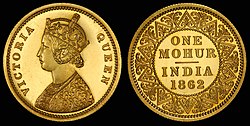TheMohuris agold cointhat was formerly minted by several governments, includingBritish Indiaand some of theprincely stateswhich existed alongside it, theMughal Empire,Maratha Empire,Kingdom of Nepal,andPersia(chieflyAfghanistan). It was usually equivalent in value to fifteen silverrupees.It was last minted in British India in 1918, but some princely states continued to issue the coins until theiraccessionto India after 1947. Similar coins were also issued by the British authorities in denominations of2⁄3mohur (10 rupees),1⁄3mohur (5 rupees) and the double mohur (30 rupees), and some of the princely states issued half-mohur coins (equal to 7 rupees and 8 anna).
Themohurcoin was first introduced bySher Shah Suriduring his rule in India between 1540 and 1545 and was then a gold coin weighing 169grains(10.95 grams). He also introducedcoppercoins calleddamandsilver coinscalledrupiyathat weighed 178 grains (11.53 grams).[3]Later on, theMughal emperorsstandardized this coinage of tri-metallism across the sub-continent in order to consolidate the monetary system.
Etymology
editThe wordmohurormohor(from the Persian wordmuhr,which means "seal" or "signet ring"[6]) iscognatewith theSanskritwordmudrā,which in turn comes frommudraṇam,which also means "seal".[7]
Collector value
editGold mohurs issued by the Mughal Empire, the British East India Company or the British Crown are valuable collector items and sell in auctions for high prices. The double mohur (minted between 1835 and 1918) with a value of 30 rupees is the highest denomination circulating coin issued till date. An 1835 double mohur was sold at aBangaloreauction for ₹11.5lakhsmaking it the highest ever coin bid in India.[8]
See also
editReferences
editFootnotes
editNotes
edit- ^Cuhaj, George S., ed. (2009b).Standard Catalog of World Coins 1801–1900(6 ed.). Krause. p. 752.ISBN978-0-89689-940-7.
- ^Cuhaj, George S., ed. (2009a).Standard Catalog of World Gold Coins 1601–Present(6 ed.). Krause. p. 818.ISBN978-1-4402-0424-1.
- ^Mughal CoinageArchived2008-05-16 at theWayback MachineatRBI Monetary Museum.Retrieved on May 4, 2008.
- ^Smith 1917,p. 274.
- ^Gibbs, J. (1865).Proceedings of the Asiatic Society of Bengal.Calcutta. pp. 4–5.
- ^"mohur".Oxford English Dictionary(Online ed.).Oxford University Press.(Subscription orparticipating institution membershiprequired.)
- ^ "Sanskritdictionary.com: Definition of mudraṇam".sanskritdictionary.com.
- ^Srivatsa, Sharath S. (February 20, 2012)."Collector mints a fortune from coin auction"– via www.thehindu.com.

